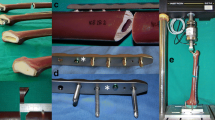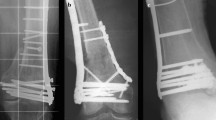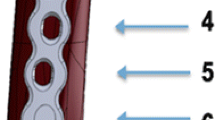Abstract
Introduction
Periprosthetic fractures after cemented hip replacement are a challenging problem to manage. Biomechanical studies have suggested the benefit of using locking screws for plate fixation, but there are concerns whether screws damage the cement mantle and promote crack propagation leading to construct failure.
Method
In this biomechanical study, different screw types were implanted into the cement mantle after pre-drilling holes of different sizes, in unicortical and bicortical configuration. The presence of cracks and the pull-out resistance of these screws were then evaluated.
Results
No unicortical screw induced cracks. Screws with a shortened tip, smaller flutes and double threads were significantly better for pull-out resistance. Bicortical screws were associated with a risk of local cement mantle damage, but also with a significantly greater holding power. By increasing the drill diameter, the onset of cracks decreased, but so does the pull-out resistance.







Similar content being viewed by others
References
Lindahl H et al (2006) Three hundred and twenty-one periprosthetic femoral fractures. J Bone Joint Surg Am 88(6):1215–1222
Berry DJ (1999) Epidemiology: hip and knee. Orthop Clin North Am 30(2):183–190
Learmonth ID (2004) The management of periprosthetic fractures around the femoral stem. J Bone Joint Surg Br 86(1):13–19
Lindahl H et al (2005) Periprosthetic femoral fractures classification and demographics of 1049 periprosthetic femoral fractures from the Swedish National Hip Arthroplasty Register. J Arthroplasty 20(7):857–865
Bethea JSIII et al (1982) Proximal femoral fractures following total hip arthroplasty. Clin Orthop Relat Res 170:95–106
Brady OH et al (1999) Classification of the hip. Orthop Clin North Am 30(2):215–220
Brady OH et al (2000) The reliability and validity of the Vancouver classification of femoral fractures after hip replacement. J Arthroplasty 15(1):59–62
Duncan CP, Masri BA (1995) Fractures of the femur after hip replacement. Instr Course Lect 44:293–304
Duwelius PJ et al (2004) A prospective modernized treatment protocol for periprosthetic femur fractures. Orthop Clin North Am 35(4):485–492, vi
Van Flandern GJ (2005) Periprosthetic fractures in total hip arthroplasty. Orthopedics 28(9 Suppl):s1089–s1095
Lindahl H et al (2006) Risk factors for failure after treatment of a periprosthetic fracture of the femur. J Bone Joint Surg Br 88(1):26–30
Young SW et al (2007) Periprosthetic femoral fractures after total hip arthroplasty. ANZ J Surg 77(6):424–428
Fulkerson E et al (2006) Fixation of periprosthetic femoral shaft fractures associated with cemented femoral stems: a biomechanical comparison of locked plating and conventional cable plates. J Orthop Trauma 20(2):89–93
Dennis MG et al (2000) Fixation of periprosthetic femoral shaft fractures occurring at the tip of the stem: a biomechanical study of 5 techniques. J Arthroplasty 15(4):523–528
Schmotzer H, Tchejeyan GH, Dall DM (1996) Surgical management of intra- and postoperative fractures of the femur about the tip of the stem in total hip arthroplasty. J Arthroplasty 11(6):709–717
Yerby S et al (2001) Effect of cutting flute design on cortical bone screw insertion torque and pullout strength. J Orthop Trauma 15(3):216–221
Giannoudis PV, Kanakaris NK, Tsiridis E (2007) Principles of internal fixation and selection of implants for periprosthetic femoral fractures. Injury 38(6):669–687
Serocki JH, Chandler RW, Dorr LD (1992) Treatment of fractures about hip prostheses with compression plating. J Arthroplasty 7(2):129–135
Cooke PH, Newman JH (1988) Fractures of the femur in relation to cemented hip prostheses. J Bone Joint Surg Br 70(3):386–389
Acknowledgment
This study was supported by the APOS (Asia Pacific Orthopaedic Symposium) research grant. We kindly thank Zimmer and Synthes who provided screws and cement for this study. We acknowledge the assistance of Albert Hansma and Rochelle Nicholls from Fremantle Hospital for their help at performing this study.
Author information
Authors and Affiliations
Corresponding author
Rights and permissions
About this article
Cite this article
Kampshoff, J., Stoffel, K.K., Yates, P.J. et al. The treatment of periprosthetic fractures with locking plates: effect of drill and screw type on cement mantles: a biomechanical analysis. Arch Orthop Trauma Surg 130, 627–632 (2010). https://doi.org/10.1007/s00402-009-0952-3
Received:
Published:
Issue Date:
DOI: https://doi.org/10.1007/s00402-009-0952-3




